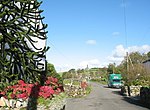Mynydd Graig Goch
ClynnogDolbenmaenHewitts of WalesMountains and hills of GwyneddMountains and hills of Snowdonia ... and 1 more
Nuttalls

Mynydd Graig Goch (Welsh, 'mountain of the red rock') is the western end peak of the Nantlle Ridge, and is a subsidiary summit of Craig Cwm Silyn. It is also the most westerly 2000 ft peak in Wales. For many years it was excluded from lists of the Welsh 2000 ft mountains due to a spot height of 609 metres (1998') on OS maps. However, this changed in 2008; after years of speculation a group of hillwalkers carried out a precise GPS survey of the peak, measuring the absolute height as 609.75 metres (2000 ft 6 in).
Excerpt from the Wikipedia article Mynydd Graig Goch (License: CC BY-SA 3.0, Authors, Images).Mynydd Graig Goch
Lôn Tyddyn Agnes,
Geographical coordinates (GPS) Address Nearby Places Show on map
Geographical coordinates (GPS)
| Latitude | Longitude |
|---|---|
| N 53.012807 ° | E -4.241368 ° |
Address
Lôn Tyddyn Agnes
LL54 6RT , Llanllyfni
Wales, United Kingdom
Open on Google Maps









